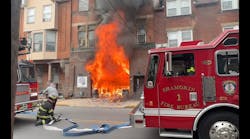BOISE, Idaho (AP) -- The Forest Service permanently grounded 11 airtankers and temporarily grounded other planes used to fight wildfires after an expert panel said Friday the aerial firefighting program is unsafe and plagued with problems.
The panel's report was prompted by the deaths of six fire crew members in two airtanker crashes and a helicopter crash earlier this year.
The permanently grounded planes carry too high a risk to use, said Forest Service Fire Director Jerry Williams, and a long-term solution could mean building planes specifically for fighting wildfires, at a cost of $20 million each.
The grounded tankers were all C-130A or PB4Y-2 models used under contract with private companies. They delivered about 10 percent of the water and foam dropped on wildfires.
Nineteen government-owned P-58 lead planes and four Sherpa smokejumper aircraft were grounded pending evaluation of safety issues identified in the experts' report.
The remaining 33 airtankers must pass a rigorous inspection and follow a new maintenance program before they are returned to duty, Williams said. Those airtankers are government owned or leased or have structural differences from the grounded planes.
``We are going to reduce public and employee exposure to what we perceive as high-risk aircraft,'' Williams said. ``The contractors did not identify structural problems.''
During next year's fire season, more helicopters could be used and military planes may be called in if the fleet runs short, Williams said.
The expert panel, appointed by the federal government, found the aerial firefighting program had a pass-the-buck approach to safety standards, inadequate training, lacked communication between agencies and focused on compliance rather than safety.
Forest Service Chief Dale Bosworth and BLM Director Kathy Clarke enlisted the aviation experts, led by former National Transportation Safety Board chairman Jim Hall and Texas state forester Jim Hull, to study the issue in August.
The report faulted the Federal Aviation Administration for leaving to contractors the certification and inspection of the aircraft, many of which are modified World War II military tankers.
``The FAA apparently sees no statutory requirement to oversee airworthiness,'' said William Scott, panel member and bureau chief for Aviation Week and Space Technology Magazine. ``This creates a dangerous situation.''
But Allen Kenitzer, FAA spokesman in Seattle, said the administration is not authorized by Congress to set standards for aircraft used by the government. Only when the planes are being used privately, and not under Forest Service contract, are they subject to FAA standards, Kenitzer said.
That leaves Forest Service, Bureau of Land Management or private contract personnel to decide if an aircraft is safe to fly.
``Private operators, for the most part, have done an admirable job of keeping these aging aircraft flying,'' the report said. ``However, they are handicapped by receiving little, if any, support from former military operators and the aircraft's original manufacturer.''
While endorsing change, both Williams and Bureau of Land Management Fire Director Larry Hamilton cited budgetary limitations and another fire season just months away.
The aviation program came under scrutiny after the wings sheared off two airtankers because of fatigue cracks. Three people were killed in June when the wings separated from a C-130A being used to fight a fire in California. In late July, a PB4Y-2 broke up and crashed fighting a Colorado fire, killing its two-man crew. The planes were respectively 46 and 57 years old.
Both planes were operated by Hawkins and Powers Aviation, a Greybull, Wyo., company that contracts with the Forest Service to provide firefighting tankers.
On July 30, an Aerospatiale SA 315B Lama helicopter suffered an engine failure and crashed in Colorado, killing the pilot.
The panel also found that the firefighting agencies allowed contract pilots and crews to fly under safety standards that were lower than for those flying in other government missions.
Special requirements were not set to accommodate the severe conditions of fighting fires from the air, the report said.
Earlier:





